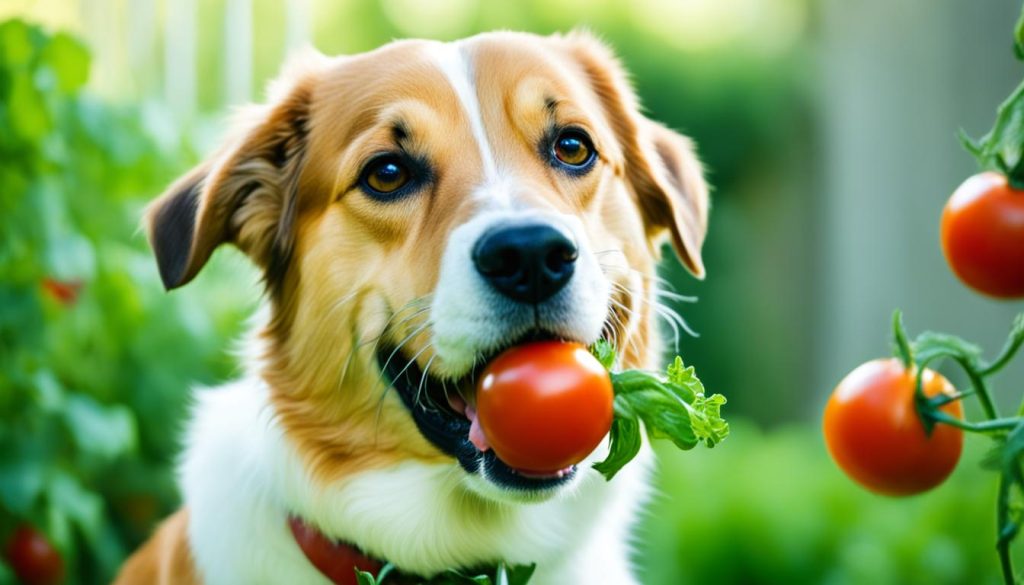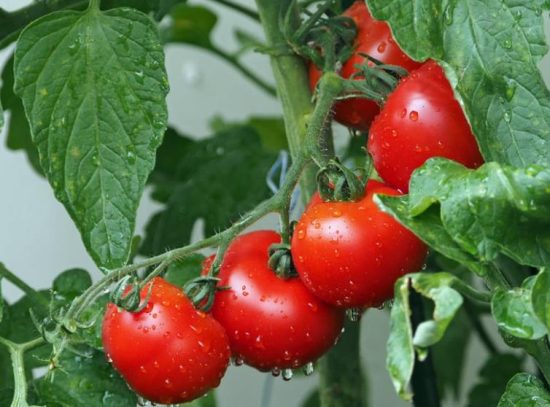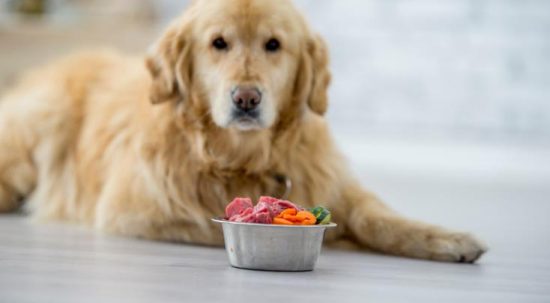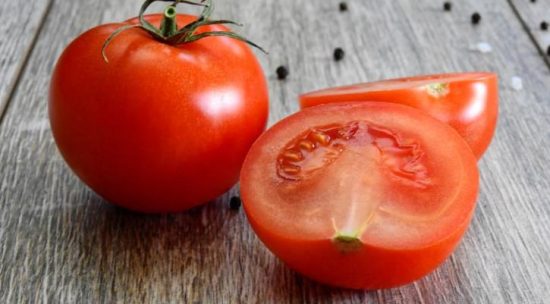Can Dogs Eat Tomatoes? A Guide to Feeding Tomatoes Safely
Discover if your furry friend can enjoy tomatoes safely. Our comprehensive guide breaks down the dos and don’ts for sharing this fruit with dogs.

Tomatoes are a popular ingredient in many meals and dog foods, but can dogs eat tomatoes? Have you ever wondered whether feeding tomatoes to your furry friend is a good idea? You’re not alone. There’s a lot of conflicting information out there about whether tomatoes are safe or harmful for dogs.
In this comprehensive guide, we’ll delve into the topic of feeding tomatoes to dogs and provide you with all the information you need to make an informed decision. From understanding the nutritional value of tomatoes for dogs to identifying safe parts of a tomato, as well as the potential dangers of solanine and tomatine, we will cover everything you need to know about feeding tomatoes to your dog safely.
Understanding Tomatoes and Canine Health

Tomatoes are packed with nutrients that can benefit both humans and dogs. Understanding the health benefits of tomatoes for dogs is essential to determine whether they can be part of their diet. This section will explore the nutritional value of tomatoes for dogs, including the vitamins found in tomatoes and the fiber and antioxidant benefits they offer. By understanding the positive effects tomatoes can have on canine health, you can make informed decisions about incorporating them into your dog’s diet.
Tomatoes are a rich source of vitamins and minerals that support your dog’s overall health and well-being. They are particularly high in vitamins A and C, which play a crucial role in boosting your dog’s immune system and promoting healthy skin and coat. These vitamins are essential for maintaining your dog’s optimal health.
In addition to vitamins, tomatoes contain fiber and antioxidants that can benefit your dog’s digestive system. Fiber helps regulate bowel movements and prevent constipation, while antioxidants protect against cell damage caused by harmful free radicals. Incorporating tomatoes into your dog’s diet can support their digestive health and provide valuable antioxidants to promote overall well-being.
When feeding tomatoes to your dog, it’s important to consider their nutritional needs and portion sizes. While tomatoes offer health benefits, they should be given in moderation as part of a balanced diet. Too much of any food, including tomatoes, can cause digestive upset or other health issues.
The Nutritional Value of Tomatoes for Dogs
Tomatoes are not only delicious but also full of essential nutrients for dogs. This section will delve into the specific vitamins found in tomatoes that can benefit your furry friend’s health. Additionally, tomatoes are a great source of fiber and antioxidants, which can aid in digestion and reduce the risk of illness.
Vitamins Found in Tomatoes
Tomatoes contain a variety of vitamins that are beneficial for dogs. One important vitamin found in tomatoes is vitamin A, which promotes good vision and supports a healthy immune system. Vitamin C, another crucial vitamin, is known for its antioxidant properties and its ability to boost the immune system. Other vitamins found in tomatoes include vitamin K, which plays a role in blood clotting, and vitamin B6, which helps regulate metabolism.
To give your dog the vitamins they need from tomatoes, it is essential to provide them in moderation. As part of your dog’s balanced diet, consider incorporating tomatoes as a treat or a supplement to their regular food.
Fiber and Antioxidant Benefits
In addition to vitamins, tomatoes are also a great source of fiber and antioxidants. Fiber helps regulate digestion and can prevent gastrointestinal issues such as constipation. Including tomatoes in your dog’s diet can help promote healthy bowel movements and overall digestive health.
Antioxidants, on the other hand, play a crucial role in reducing inflammation and boosting the immune system. The antioxidants found in tomatoes can help protect your dog’s cells from damage caused by free radicals, which are unstable molecules that can lead to various health issues. By including tomatoes in your dog’s diet, you are providing them with a natural source of antioxidants that can contribute to their overall well-being.
| Nutrients | Benefits |
|---|---|
| Vitamins | Support immune health and overall well-being |
| Fiber | Aids in digestion and promotes healthy bowel movements |
| Antioxidants | Reduces inflammation and boosts the immune system |
Identifying Safe Parts of a Tomato for Dogs
While tomatoes offer nutritional benefits for dogs, it’s essential to understand which parts of a tomato are safe for them to consume. By identifying the safe parts and avoiding potential hazards, you can ensure that your furry friend can enjoy tomatoes without any adverse effects.
When it comes to feeding tomatoes to dogs, it is generally safe to serve the fleshy part of the tomato. The juicy pulp provides dogs with essential vitamins and minerals, contributing to their overall health and well-being.
However, there are certain parts of the tomato that should be avoided. Can dogs eat tomato skins? In general, it is recommended to remove the skin before feeding a tomato to your dog. The skin of a tomato can be tough and can potentially cause digestive issues or choking hazards. Removing the skin also eliminates any residues of pesticides or contaminants that might be present.
Another part of the tomato that should be avoided is the seeds. Can dogs eat tomato seeds? It is best to remove the seeds as they can pose a choking hazard due to their small size. Additionally, tomato seeds contain trace amounts of tomatine, a natural toxin found in tomatoes. While the levels of tomatine in tomato seeds are low, it’s advisable to err on the side of caution and remove them before giving tomatoes to your dog.
The Dangers of Solanine and Tomatine in Tomatoes
Solanine and tomatine are natural chemicals that can be found in tomatoes, particularly in green and unripe tomatoes. While tomatoes are generally safe for consumption, it is important to be aware of the potential dangers of solanine and tomatine in tomatoes, especially when it comes to feeding them to dogs.

What are Solanine and Tomatine?
Solanine and tomatine are glycoalkaloids, toxic compounds that naturally occur in certain members of the nightshade family, including tomatoes. These chemicals act as a defense mechanism in the plant, deterring pests and pathogens. While they are generally present in small amounts, green and unripe tomatoes tend to contain higher levels of solanine and tomatine.
Symptoms of Tomatine Poisoning in Dogs
In dogs, excessive consumption of tomatoes containing high levels of solanine and tomatine can lead to symptoms of poisoning. Common symptoms include gastrointestinal upset, such as vomiting and diarrhea, as well as drooling, lethargy, and weakness. In severe cases, dogs may also experience tremors, difficulty breathing, and even seizures.
To ensure the safety and well-being of your furry friend, it is important to monitor their tomato consumption and seek veterinary care if you suspect tomatine poisoning. Be cautious when feeding tomatoes to your dog, and consider consulting your veterinarian for guidance on safe portions and preparation methods.
Can Dogs Eat Tomatoes?

Feeding tomatoes to dogs can be a safe option if done in moderation and following proper guidelines. Although tomatoes contain solanine and tomatine, which can be harmful to dogs in large quantities, they can still enjoy this fruit in controlled portions.
When incorporating tomatoes into your dog’s diet, it’s important to be mindful of the appropriate portion sizes and frequency of consumption. This ensures that your furry friend can reap the nutritional benefits of tomatoes without compromising their health.
One approach to feeding tomatoes to dogs in moderation is to offer them as an occasional treat or as part of a well-balanced meal. This way, you can provide variety in their diet while keeping an eye on their overall tomato consumption.
It’s essential to consult with your veterinarian to determine the specific portion sizes and frequency that are suitable for your dog. Factors such as their size, age, and individual health needs should be taken into consideration.
By being mindful of the amount of tomatoes you feed your dog and following your veterinarian’s guidance, you can ensure that your furry friend can enjoy this fruit without any adverse effects. Remember, moderation is key when it comes to feeding tomatoes to dogs.
The Difference Between Ripe and Unripe Tomatoes
When it comes to feeding tomatoes to your dog, understanding the difference between ripe and unripe tomatoes is crucial. Ripe tomatoes are those that have reached their peak of sweetness and flavor, while unripe tomatoes are still green and haven’t fully matured.
When Are Tomatoes Safe for Dogs?
Tomatoes are generally safe for dogs to consume when they are ripe. Ripe tomatoes have lower levels of solanine and tomatine, the natural chemicals found in green and unripe tomatoes that can be harmful to dogs in large quantities. When tomatoes are fully ripe, these toxins are significantly reduced, making them safer for your furry friend to enjoy in moderation.
Risks Associated with Green Tomatoes
On the other hand, green and unripe tomatoes pose higher risks for dogs. These tomatoes contain higher levels of solanine and tomatine, which can lead to digestive upset, stomach pain, and even toxicity if consumed in large amounts. It’s important to avoid feeding green tomatoes to your dog to prevent potential health issues.
How to Safely Introduce Tomatoes into Your Dog’s Diet?

When introducing a new food like tomatoes into your dog’s diet, it’s essential to do so safely. Follow these guidelines to ensure a smooth transition and minimize any potential digestive issues.
1. Start with small amounts: Begin by offering your dog a small piece of fresh tomato. Monitor their reaction and observe if there are any signs of discomfort or allergic reactions such as itching or vomiting. If your dog tolerates the tomato well, you can gradually increase the portion size over time.
2. Remove the skin, seeds, and stem: To minimize the risk of digestive issues, it’s recommended to remove the skin, seeds, and stem of the tomato before feeding it to your dog. These parts can be difficult to digest and may pose a choking hazard. Cut the tomato into small, bite-sized pieces without the skin, seeds, or stem.
3. Cooked or raw: While it’s generally safe to feed dogs raw tomatoes, some pet owners prefer to cook them before serving. Cooking can make the tomatoes softer and easier to digest for dogs with sensitive stomachs. However, avoid cooking tomatoes with spices, seasonings, or other ingredients that may be harmful to dogs.
4. Monitor for adverse reactions: Pay close attention to your dog’s reaction to the introduction of tomatoes into their diet. Look for any signs of gastrointestinal issues such as diarrhea, vomiting, or changes in appetite. If your dog experiences any adverse reactions, discontinue feeding them tomatoes and consult with your veterinarian.
5. Moderation is key: While tomatoes can provide nutritional benefits to dogs, it’s important to remember that they should be given in moderation. Like any new food, it’s always best to introduce it gradually and monitor your dog’s response. Too many tomatoes can lead to digestive upset or other health issues.
Common Misconceptions About Dogs and Tomatoes

Many misconceptions surround the topic of dogs and tomatoes, with some falsely labeling tomatoes as “poisonous” for dogs. It’s time to debunk these common myths and provide you with the truth about tomatoes as a safe food option for your furry friend.
Truth About Tomatoes as ‘Poison’
Contrary to popular belief, tomatoes are not inherently poisonous to dogs. While certain parts of the tomato plant, such as the leaves and stems, contain small amounts of solanine and tomatine, these substances are present in minimal quantities in the ripe fruit itself. When fed in moderation and prepared correctly, tomatoes can be a safe and nutritious addition to your dog’s diet.
Deciphering Myths from Facts
Let’s separate fact from fiction when it comes to dogs and tomatoes. Here are a few common misconceptions debunked:
- Myth: All parts of the tomato plant are toxic for dogs.
Fact: While the leaves and stems should be avoided, the ripe fruit of the tomato is safe for dogs in moderation. - Myth: Tomatoes can cause kidney damage in dogs.
Fact: Tomatoes, when fed in appropriate amounts, do not pose a risk to a healthy dog’s kidneys. - Myth: Dogs should never be fed any tomato-based products.
Fact: While some tomato-based products may contain ingredients that are harmful to dogs, such as onions or garlic, plain and properly prepared tomato sauce or soup without these harmful additives can be safe for your dog in small portions.
Preventing Tomatine Poisoning: Tips for Dog Owners
Taking preventative measures to ensure the safety and well-being of your furry friend is crucial when it comes to tomatine poisoning in dogs. By following these tips, you can minimize the risk and keep your dog safe from potential harm.
Monitoring Your Dog’s Tomato Consumption
It’s important to closely monitor your dog’s tomato consumption to prevent tomatine poisoning. Ensure that your dog doesn’t have access to unripe, green tomatoes as they contain higher levels of tomatine. When feeding your dog tomatoes, remove the stems, leaves, and any green or unripe parts to reduce tomatine content. Additionally, limit the amount of tomatoes your dog consumes, as excessive intake can lead to poisoning.
First Aid for Suspected Poisoning
If you suspect your dog has been poisoned by tomatine, it’s important to take immediate action. Here are some first aid steps you can take:
- Assess the situation: Keep calm and observe your dog’s symptoms. Look out for signs such as vomiting, diarrhea, drooling, weakness, tremors, or difficulty breathing.
- Contact your veterinarian: Call your veterinarian immediately for guidance on what steps to take next. They may ask you to induce vomiting or bring your dog in for further evaluation and treatment.
- Follow veterinary instructions: Follow your veterinarian’s instructions carefully. They may recommend administering activated charcoal or other medications to help counteract the effects of tomatine poisoning.
- Provide supportive care: Keep your dog comfortable and hydrated. Monitor their vital signs and behavior closely, and seek veterinary assistance if their condition worsens.
Remember, prompt action is essential when it comes to tomatine poisoning. Contacting your veterinarian as soon as possible can greatly improve your dog’s chances of a full recovery.
| Symptoms of Tomatine Poisoning | First Aid Steps |
|---|---|
| Vomiting | Assess the situation |
| Diarrhea | Contact your veterinarian |
| Drooling | Follow veterinary instructions |
| Weakness | Provide supportive care |
| Tremors | |
| Difficulty breathing |
Tomato-Based Foods and Canine Consumption
While incorporating fresh tomatoes into your dog’s diet can be safe in moderation, the same may not apply to tomato-based foods. It’s essential to understand the safety of tomato-based foods for canine consumption and any potential risks associated with them.
Can dogs eat tomato sauce? Can dogs eat tomato soup? These are common questions among pet owners, and the answers depend on the ingredients and preparation methods used in these foods.
Tomato sauce and tomato soup often contain additional ingredients such as spices, seasonings, and high levels of sodium, which can be harmful to dogs in large quantities. Some tomato sauces may also contain ingredients like onions or garlic, which are toxic to dogs and can cause digestive upset or even more serious health issues.

It’s crucial to read the ingredient labels carefully and ensure that any tomato-based foods you offer to your dog are free from harmful additives and safe for canine consumption. If you are unsure about a specific product, it’s best to consult with your veterinarian for guidance.
As with any new food, it’s recommended to introduce tomato-based foods to your dog gradually and in small amounts to monitor their reaction and prevent any potential digestive upset.
Remember that the primary diet for dogs should consist of nutritionally balanced dog food that meets their specific dietary needs. Treats or occasional additions, such as fresh tomatoes, can be given in moderation but should not replace their regular meals.
Considering Dog Size When Feeding Tomatoes
When it comes to feeding tomatoes to your dog, it’s important to take their size into consideration. Dogs of different sizes have varying nutritional needs, and adjusting tomato portions accordingly can ensure they receive the right balance of nutrients. Whether you have a small breed like a Chihuahua or a larger breed like a Golden Retriever, understanding the appropriate portion sizes of tomatoes is key to maintaining their health and well-being.
Quantity Guidelines for Different Dog Breeds
Feeding tomatoes to dogs based on their size requires careful consideration. As a general guideline, smaller dog breeds should be given smaller portions of tomatoes, while larger breeds can tolerate larger portions. Here are some quantity guidelines to help you determine suitable portions based on your dog’s breed:
| Dog Breed | Tomato Portion |
|---|---|
| Small Breeds (e.g., Chihuahua, Yorkshire Terrier) | 1-2 cherry tomatoes or 1-2 tablespoons of diced tomatoes |
| Medium Breeds (e.g., Beagle, Cocker Spaniel) | 2-3 cherry tomatoes or 2-3 tablespoons of diced tomatoes |
| Large Breeds (e.g., Labrador Retriever, German Shepherd) | 3-4 cherry tomatoes or 3-4 tablespoons of diced tomatoes |
These guidelines are approximate and can be adjusted based on your dog’s individual needs, activity level, and overall health. It’s always a good idea to consult with your veterinarian for personalized advice.
Adjusting Portions for Your Dog’s Health
While following the quantity guidelines based on dog breed can provide a starting point, it’s essential to consider your dog’s overall health. Factors such as age, weight, and any underlying health conditions should be taken into account when adjusting tomato portions. For example, if your dog is overweight or prone to gastrointestinal issues, you may need to reduce the amount of tomatoes they consume. On the other hand, if your dog is highly active or has specific dietary requirements, they may benefit from slightly larger portions of tomatoes.
Monitoring your dog’s health and observing how they respond to tomato consumption can help you determine whether you need to increase or decrease the portion sizes. It’s always best to introduce new foods gradually and observe any potential adverse reactions or digestive issues. Additionally, remember that tomatoes should be given as part of a balanced diet and not as a sole source of nutrition.
Exploring Alternative Fruits Safe for Dogs

If you’re looking to expand your dog’s fruit options beyond tomatoes, there are several safe and delicious alternatives to consider. Incorporating a variety of fruits into your dog’s diet can provide them with a diverse range of nutrients and flavors. Here are some alternative fruit options that are safe for dogs:
| Fruit | Benefits |
|---|---|
| Apples | Rich in vitamins A and C, as well as fiber. Remove seeds and core before feeding. |
| Blueberries | Loaded with antioxidants and fiber. Serve them fresh or frozen as a tasty treat. |
| Bananas | High in potassium and natural sugars. Offer small pieces as a healthy snack. |
| Watermelon | Hydrating and low in calories. Remove seeds and rind before serving. |
| Pineapple | Packed with vitamins, minerals, and digestive enzymes. Serve in moderation due to high sugar content. |
| Strawberries | Rich in antioxidants and vitamin C. Remove stems and offer in small portions. |
Remember to introduce new fruits gradually and in small quantities to ensure your dog’s digestive system can tolerate them. It’s also important to remove any seeds, pits, cores, or rinds that can be hazardous to your dog’s health. Always consult with your veterinarian before making any significant changes to your dog’s diet to ensure their specific nutritional needs are met. With these alternative fruit options, you can provide your dog with a diverse and nutritious diet that satisfies their taste buds.
FAQs on can dogs eat tomatoes
What are the health benefits of tomatoes for dogs?
Tomatoes are packed with essential nutrients, including vitamins A and C, fiber, and antioxidants, which can support immune health, aid in digestion, and reduce the risk of illness in dogs.
Can dogs eat tomato skins and seeds?
It is generally recommended to remove tomato skins and seeds before feeding them to dogs to minimize any potential digestive issues.
What are solanine and tomatine, and why are they dangerous for dogs?
Solanine and tomatine are natural chemicals found in tomatoes, particularly in green and unripe tomatoes. In large quantities, they can be harmful to dogs and may cause symptoms of tomatine poisoning.
Can dogs eat tomatoes in moderation?
Yes, dogs can enjoy tomatoes in moderation. It’s important to understand appropriate portion sizes and frequency of tomato consumption for dogs to maintain their overall health and well-being.
When are tomatoes safe for dogs to consume?
Tomatoes are safe for dogs to consume when they are ripe. Green tomatoes, which contain higher levels of solanine and tomatine, should be avoided.
How can I safely introduce tomatoes to my dog’s diet?
To safely introduce tomatoes into your dog’s diet, start with small amounts and monitor their reaction. Gradually increase the quantity and frequency over time to minimize any digestive issues.
Are tomatoes poisonous for dogs?
There are misconceptions surrounding tomatoes being labeled as “poisonous” for dogs. While solanine and tomatine can be harmful in large quantities, tomatoes can be safely incorporated into a dog’s diet when given in moderation and prepared correctly.
How can I prevent tomatine poisoning in dogs?
To prevent tomatine poisoning, it’s important to monitor your dog’s tomato consumption, avoid feeding them green tomatoes or large amounts of tomatoes, and be aware of the symptoms of tomatine poisoning. If you suspect your dog has been poisoned, seek veterinary assistance immediately.
Can dogs eat tomato-based foods like tomato sauce or tomato soup?
While fresh tomatoes can be safe for dogs, tomato-based foods like tomato sauce or tomato soup may contain additional ingredients that could be harmful to dogs. It’s best to consult with your veterinarian before feeding these foods to your dog.
How much tomatoes should I feed my dog based on their size?
The quantity of tomatoes to feed your dog should be based on their size. Consult with your veterinarian for specific portion guidelines for different dog breeds and adjust the tomato portions to maintain your dog’s overall health and well-being.





